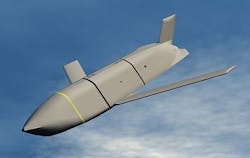Navy moves Long-Range Anti-Ship Missile (LRASM) project forward to integration and test
PATUXENT RIVER NAS, Md., 16 May 2016. Smart munitions designers at Lockheed Martin Corp. will fine-tune their design for the U.S. Navy's next-generation LRASM anti-ship missile with a $321.8 million integration and test phase contract announced Friday.
Officials of the Naval Air Systems Command at Patuxent River Naval Air Station, Md., are asking the Lockheed Martin Missiles and Fire Control segment in Orlando, Fla., to complete integration and test of the Long Range Anti-Ship Missile (LRASM).
LRASM is a joint project of the U.S. Defense Advanced Projects Agency (DARPA) in Arlington, Va., the Navy, and U.S. Air Force to design an advanced anti-ship missile that can be launched from the Navy F/A-18E/F Super Hornet jet fighter bomber, as well as from the Air Force B-1 Lancer long-range bomber.
Pentagon leaders say they hope to start buying production models of the LRASM as early as next year. Eventually versions of the mission also should be ready for launch by the Vertical Launch System (VLS) aboard Navy surface warships. Submarine-launched versions are under consideration.
Lockheed Martin has been designing LRASM for the last seven years primarily under DARPA supervision. The advanced anti-ship missile is intended to replace the ageing Harpoon anti-ship missile.
Lockheed Martin designers have based LRASM on the AGM-158B Joint Air-to-Surface Standoff Missile – Extended Range (JASSM-ER). LRASM has a multi-mode radio frequency sensor, a new weapon data-link and altimeter, and an uprated power system.
The LRASM integration and test phase determines the quality of the system as it performs under a wide variety of conditions so that designers can uncover and fix defects early in the process. The earlier a defect is found in the development process the less expensive the fix, experts say, and reduces risks such as schedule delays or cost overruns.
The LRASM can be guided toward enemy ships from as far away as 200 nautical miles by its launch aircraft, as well as receive updates via its datalink, or use onboard sensors to find its target. LRASM will fly towards its target at medium altitude then drop to low altitude for a sea skimming approach to counter anti-missile defenses.
The LRASM will use on-board targeting systems to acquire the target independently without the presence of prior, precision intelligence, or supporting services like Global Positioning System satellite navigation and data-links. The missile will be designed with advanced counter-countermeasures to evade hostile active defense systems.
Friday's Navy contract calls for Lockheed Martin to finish all the LRASM's remaining hardware and software detailed design; retiring any open risks; verify compliance with requirements; and prepare LRASM for production and deployment.
story continues below
This integration and test phase also completes full system integration; incorporates an affordable and executable LRASM manufacturing process into Lockheed Martin's existing JASSM-ER production process; examines and defines the logistics footprint; designs for producibility; ensures affordability; adds anti-tamper and cyber security; and demonstrates system integration, interoperability, safety, and utility, Navy officials say.
Lockheed Martin has conducted additional LRASM flight tests against surrogate targets from the Navy, with an eye to deploying LRASM on the B-1B bomber in 2018, and on the F/A-18E/F in 2019.
In fall 2014 Lockheed Martin conducted its second LRASM flight test in a launch from an Air Force B-1B bomber off the Southern California coast. Flying over the sea range at Point Mugu, Calif., a the B-1B bomber from the 337th Test and Evaluation Squadron at Dyess Air Force Base, Texas, released the LRASM, which navigated through all planned waypoints receiving in-flight targeting updates from the system's Weapon Data Link, Lockheed Martin officials say.
After switching to autonomous guidance, the LRASM identified the target using inputs from the onboard sensors, descended for final approach, verified the target, and hit it.
The Lockheed Martin LRASM has a 1,000-pound penetrator and blast-fragmentation warhead, multi-mode sensor, weapon data link, and enhanced digital anti-jam global positioning system to detect and destroy selected surface targets within groups of ships.
Lockheed Martin is in charge of LRASM overall development, and the BAE Systems Electronic Systems segment in Nashua, N.H., is developing the LRASM onboard sensor systems. The Office of Naval Research (ONR) in Arlington, Va., also has been involved in LRASM development.
LRASM development is in response to a gap in Navy anti-ship missile technology identified in 2008. The standard Navy anti-ship missile is the subsonic Harpoon, which has been in the inventory since 1977.
On this contract Lockheed Martin will do its work in Orlando and Ocala, Fla.; and in Troy, Ala.; , and should be finished by August, 2019. For more information contact Lockheed Martin Missiles and Fire Control online at www.lockheedmartin.com/us/mfc, or Naval Air Systems Command at www.navair.navy.mil.

